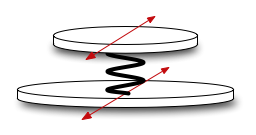Two-Mass - Mono-directional
A simple bi-directional two-mass model that can serve as a hammer, plectrum, finger, etc. Generally the two-mass model has a small mass and a large mass; the small one will be "connected" to the object being excited, and the large one will be manipulated by the user. This is similar to the bi-two-mass, except that it only vibrates in the trans0 direction. It is therefore more computationally efficient for single-direction interactions like plucking and striking objects.

(make-object 'mono-two-mass ... )
A 'mono-two-mass can be created using the following Lisp syntax (the default values are shown for each of the physical parameters):
(make-object 'mono-two-mass
(small-mass .01)
(large-mass .01)
(stiffness0 15000)
(freq-loss0 100)
(const-loss0 0))
All physical parameters can be numerical values or controllers.
- small-mass: The mass of the small mass in kg.
- large-mass: The mass of the large mass in kg.
- stiffness0: The stiffness of the spring in the 'trans0 (horizontal) direction.
- freq-loss0: The usual frequency loss parameter. See the General Object Information for more info.
- const-loss0: The usual constant loss parameter. See the General Object Information for more info..
As always, the term horizontal used above is provided for simplification.
A 'bi-two-mass can be accessed only in its sole vibrational direction: trans0.
(make-access my-mono-two-mass my-controller 'trans0)
If the value of my-controller is 1, the access is on the small mass. If my-controller is 0, the access is on the large mass. (A value in-between takes a weighted combination of the two points.)
Options
There are no special options for the mono-two-mass.
- Modalys
- Summary
- An Introduction to Modalys
- Getting Started
- Objects
- Object Properties
- Object Reference
- One-Mass - Mono-directional (Harmonic Oscillator)
- Two-Mass - Mono-directional
- Two-Mass - Bi-directional
- String (or Rod) - Mono-directional
- String (or Rod) - Bi-directional
- Tube - open/open
- Tube - closed/open
- Tube - closed/closed
- Rectangular Membrane - Fixed
- Circular Membrane - Fixed
- Rectangular Plate - Fixed
- Circular Plate - Clamped
- Circular Plate - Free
- Rectangular Free Bar
- Violin Bridge
- Cello Bridge
- Jet Object
- Single Point Object
- Radiator Object
- Clone Object
- Save Modal Object
- Read Modal Object
- Resonance Model Object
- Piano Soundboard
- Finite Element
- Object Utilities
- Hybrid Objects
- Accesses
- Connections
- Controllers
- The Modalys Workspace
- Finite Elements
- Appendix
- Index
